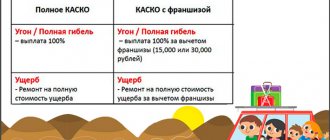The conditions under which compensation is provided are clearly stated in the insurance contract.
To receive a refund, it is important not to miss the expiration date of the document. Upon the occurrence of an insured event, the client is obliged to prove that he really is such.
To do this, the insurer is provided with the relevant documents and the expert’s assessment report. Also, the policyholder must strictly follow the rules specified in the contract.
CASCO insurance compensation is not available to just anyone. The right to receive compensation has the policyholder himself, the beneficiary or a citizen who has provided the company with a power of attorney certified by an authorized person.
In what cases will compensation be denied?
There are situations that are not covered by the CASCO policy. They do not provide for compensation of losses at the expense of the insurer. Such cases are always indicated in the rules of insurance companies and are specified in the contract.
It is impossible to receive compensation under CASCO in a number of cases:
- failure to fulfill the obligations specified in the contract, failure to submit the required documentation;
- the policyholder himself caused damage to the vehicle in order to obtain a benefit;
- gross violation of traffic rules (driving without a driver's license or while intoxicated;
- operation of the vehicle by a person not included in the insurance;
- The vehicle has been damaged by a nuclear explosion or radiation;
- the car was used for training or competitions;
- harm resulting from hostilities or civil unrest;
- confiscation or disposal of vehicles by decision of authorized bodies.
Also, the client will not receive payment if false information was provided when drawing up the insurance contract.
What should be included with it?
The documents required to submit an application for CASCO can be divided into 2 groups: general and specific.
Common documents include the following:
- a copy of the passport of the CASCO policy holder;
- a copy of the insurance holder's driver's license;
- a copy of the voluntary vehicle insurance agreement;
- a copy of the receipt for payment of the voluntary transport insurance contract;
- a copy of the state registration certificate of the car;
- a copy of the vehicle's passport.
Specific documents are divided into groups of insurance cases:
- Road traffic accident. In case of such an insured event, the applicant must attach the following to the general documents:
- a copy of the accident diagram, which is certified by the traffic police;
- traffic police report describing the accident and damage to the cars that were involved in it;
- photo and video materials of the consequences of a traffic accident.
- Theft of an insured vehicle. In case of such an insured event, the applicant is required to additionally attach the following documents:
- a copy of the protocol on the seizure of car keys and documents by traffic police officers;
- a copy of a document confirming the fact that law enforcement officers accepted a request to initiate a criminal case from the policyholder.
- Damage from the actions of third parties. In case of damage received from the actions of third parties, the applicant must supplement the general documents with the following:
- a copy of the protocol drawn up by the traffic police;
- photo and video materials confirming the damage received.
- Damage due to fire. If the policyholder's car was damaged by fire, then in addition to general documents, he will need to attach the following to the application:
- a copy of the report from the fire brigade that arrived at the scene;
- a copy of the document confirming the acceptance of the application to initiate a criminal case on the fact of arson (only if this has been established by firefighters);
- photo and video materials of damage.
- Damage received as a result of the violence of the elements. If the car was damaged by natural forces, then the following must be attached to the general list of documents:
- certificate from the hydrometeorological service;
- photo and video materials of damage.
Maximum compensation
The largest amount of damage is always limited to the insured amount specified in the CASCO agreement. These figures do not always correspond to the price of the car at the time of signing the contract, and it cannot be higher than this value.
The amount of compensation under CASCO is always limited. For example, the total amount of compensation provided during the validity of the contract does not exceed the established value - the liability limit of the insurance company.
Its size and scope of application are determined by the agreement. If the owner of the car was damaged as a result of an accident, which was issued under the Europrotocol, insurance payment is provided in accordance with the law on compulsory motor liability insurance for the Europrotocol.
Sample statement of claim for recovery of insurance payment under a CASCO agreement (download for free)
Got into an accident? Don’t know how to correctly draw up a claim for payment of insurance compensation under CASCO? A professional auto lawyer will help you.
You can download an example of a statement of claim for free on our website.
B (name of the court and its location)
Plaintiff: Full name of the plaintiff and his location
Defendant: Name of the defendant and his location
STATEMENT OF CLAIM
for payment of insurance compensation
“___”____________ 20___ between the plaintiff and the defendant a voluntary vehicle insurance agreement (CASCO) was concluded in relation to a car - indicate the details of the car, under the terms of which the insurer agreed to pay the insured in the event of an insured event compensation in the amount of __________ rubles.
According to the terms of the contract, insured events include theft of a vehicle or damage to it. The validity period of the voluntary insurance contract is set from “___” ______________ 20___ to “____”___________ 20___. During the validity period of the insurance contract, an insured event occurred, namely (indicate which insured event occurred and how it was recorded). Documents confirming the occurrence of the insured event (indicate which ones) were transferred to the insurer "____"_____________20___. Option No. 1. To date, the insurer has not paid the insurance compensation. The insurer's refusal to pay insurance compensation was based on the following circumstances (indicate the grounds for refusal) Option No. 2. The insurer, on the basis of the submitted documents in ______________20__, paid insurance compensation in the amount of _________ rubles. Having disagreed with the established amount of compensation, the plaintiff turned to (indicate the name of the expert institution), according to the report he submitted (indicate the date and number of the report), the amount of damage caused was _______________ rubles. According to the norms of the current legislation (specify which specific ones), the contract must comply with the rules mandatory for the parties established by law and other legal acts (mandatory norms) in force at the time of its conclusion, i.e. The parties do not have the right to enter into an agreement on terms that are contrary to the law. The rules of motor vehicle insurance are an integral part of the insurance contract and should not contain provisions that contradict civil legislation and worsen the conditions of the insured in comparison with those established by law. Under a property insurance contract, one party (insurer) undertakes, for a fee stipulated by the contract (insurance premium), upon the occurrence of an event stipulated in the contract (insured event), to compensate the other party (the policyholder) or another person in whose favor the contract was concluded (the beneficiary) for damages caused as a result of this events, losses in the insured property or losses in connection with other property interests of the policyholder (pay insurance compensation) within the limits of the amount specified in the contract (sum insured). Thus, the insurer is obliged to pay the policyholder (beneficiary) insurance compensation in the amount of ______ rubles. Article 9 of the Federal Law of January 26, 1996 No. 15-FZ “On the entry into force of part two of the Civil Code of the Russian Federation” determines that in cases where one of the parties to the obligation is a citizen using, purchasing, ordering or intending to purchase or order services for personal household needs, such a citizen enjoys the rights of a party to an obligation in accordance with the Civil Code of the Russian Federation, as well as the rights granted to the consumer by the Law of the Russian Federation “On the Protection of Consumer Rights” and other legal acts issued in accordance with it. Legal relations arising from contracts with the participation of citizens are regulated by the norms of the Civil Code of the Russian Federation and special laws, as well as the general rules of the Law of the Russian Federation “On the Protection of Consumer Rights”. Based on the above, the plaintiff makes a claim for compensation for moral damage caused to him in the amount of ___________ rubles. The fact of causing moral damage to the plaintiff is justified by the fact that (indicate on what the claim for compensation for moral damage is based). According to Art. 15 of the Civil Code of the Russian Federation, a person whose right has been violated may demand full compensation for the losses caused to him, unless the law or contract provides for compensation for losses in a smaller amount. Losses are understood as expenses that a person whose right has been violated has made or will have to make to restore the violated right. The expenses I incurred consist of (indicate the name of the expenses) and amount to __________ rubles. In accordance with Part 6 of Art. 13 of the Law “On the Protection of Consumer Rights”, a fine in the amount of 50% of the total amount awarded by the court in favor of the claimant is subject to recovery from the defendant in favor of the plaintiff. Based on the above and guided by Art. 15 and 1064 of the Civil Code of the Russian Federation, Art. 333.19 of the Tax Code of the Russian Federation, and in accordance with Art. Art. 131 – 214 Code of Civil Procedure of the Russian Federation I ASK: To recover from indicate the name of the defendant in favor of indicate full name. the plaintiff's amount of damage in the amount of __________ rubles, costs associated with protecting my rights in the amount of _________________, compensation for moral damage in the amount of __________ rubles, as well as a fine in the amount of __________ Appendices: The appendix lists the documents on which the plaintiff bases his claims. ____________ (signature and full name of the plaintiff) _________ (date of filing the statement of claim) 03/14/2018
Calculation of insurance payments
In the event that the vehicle is not completely lost, compensation for damages under CASCO in case of an accident will depend on the scale of the damage caused, confirmed by documents.
You can confirm the extent of damage received in the following ways:
- calculations by the insurance company for the examination of injuries received;
- official calculations of the independent expert who conducted the inspection;
- checks and other documents from the car service center chosen by the insurer;
- documentation received at the policyholder's car service center, indicating the volume of restoration work (work order) and the amount of costs.
In accordance with the CASCO insurance contract, compensation can be full or partial (depending on the degree of wear and tear of the vehicle). When the contract provides for a deductible, it is subtracted from the cost of repairs (the conditional deductible is deducted only if the damage does not exceed its amount).
If the car is stolen or cannot be repaired, the payment is provided as follows:
- the maximum possible amount at the time of the incident is limited by the established limit;
- the franchise is taken away (if it is not conditional and is generally provided for);
- the cost of usable remains (whole parts suitable for sale) is not taken into account;
- The balance of the insurance premium is not taken into account.
Among other things, other amounts provided for in the insurance contract will not be taken into account here. These include compensation previously paid under this agreement. All these aspects determine how much compensation a client can receive.
Interesting article: Registration of an electronic Casco policy.
How and where is it served?
As mentioned above, there is no state regulation of issues related to filing an application with an insurance company for CASCO. In this regard, based on the Civil Code of the Russian Federation, it can be argued that the main regulator in this matter is the agreement between the insurer and the policyholder. At the same time, there is an established practice that most insurance companies in Russia adhere to:
- The application is submitted to any office of the insurance company, at the choice of the insurance holder.
- The application must be submitted on paper with a live signature of the insurance owner.
- If the application is submitted by a representative of the policyholder, then he is obliged to provide an employee of the insurance company with a notarized power of attorney to carry out these actions.
Important! Any insurance company has the right not to adhere to general practice, therefore, in each specific case, to clarify the information, you need to refer to the contract.
How long will it take to compensate for the damage?
Each insurance company independently sets the period of compensation for CASCO insurance. Specific information is always specified in the insurer's rules and contract.
Typically this period ranges from 10 days to one calendar month. Sometimes the refund period may be extended.
This happens not only due to reluctance to provide funds, but also in the event of a delay in the receipt of parts or a queue.
In a situation where the insurer does not indicate the payment period, the client can use the Civil Code of the Russian Federation, which determines the obligation of an adequate period of compensation for damage.
Failure to fulfill obligations to the client within a month threatens the payment of compensation and a penalty for its delay. The period for compensation for damage caused to a vehicle is counted from the day the documents are submitted to the insurance company.
Payment procedure for CASCO
If the car is stolen, the insurer is obliged to compensate the amount specified in the agreement. Another question is how the damage is paid, since the car can simply be repaired. There are two ways to compensate for damage:
- payment for repair work;
- monetary compensation.
Insurance payments or repairs – the choice is up to the applicant. In this case, you should pay attention to the time frame within which funds are transferred, depending on the chosen form of compensation. Policyholders note that payment for repairs is made faster than payment of compensation in cash. The money is immediately transferred to the repair shop’s account. However, each method has its own advantages and disadvantages.
So, the advantages of choosing payment for repair work as compensation:
- accelerated payment terms;
- no need for the applicant to search for a car repair shop. The insurance company will do this for him, if such a condition is stipulated in the agreement.
Flaws:
- difficulties that arise if the repair was done poorly, usually ending in litigation;
- problems with insufficient insurance payment for repairs or vice versa, if there is an excess of insurance compensation over the amount of repair work;
- delay in completion of repairs.
Positive aspects of compensation in cash:
- the ability to choose a suitable workshop;
- carrying out repairs in a time convenient for the motorist;
- receiving cash that the owner can dispose of independently.
Of the minuses it is worth noting:
- possible underestimation of the amount of compensation, since with this form of compensation the original condition of the car is taken into account;
- limitation on the number of cash payments per year in some insurance companies;
- extended deadlines for calculating compensation.
It is worth clarifying that the period for paying compensation is also different for each insurer. It is indicated in the insurance rules, which are an appendix to the main contract. It is difficult to establish the payment period by law, since there is still not a single regulatory act regulating this issue.
Large insurance companies transfer compensation within 14 days from the date of submission of the application. For mid-level companies, this can take up to one month.
Sequence of actions when receiving payment
The insurer is contacted immediately after the documents confirming the fact of the accident or damage to the car are completed.
Only after this does the insurance company calculate the amount of compensation. We present step-by-step instructions for receiving a CASCO payment.
Notifying the insurer about the occurrence of an insured event
If damage is discovered or in the event of a traffic accident, you should call the traffic police, because the insurance company will require an official document with the recorded damage.
If the client has an accident, he should not change the location of the car. The arriving employees describe the damage caused, indicating all participants in the incident. It is necessary to ensure that you do not include in the document a column like “I have no complaints against the participants in the incident.”
If you miss this moment, you may be left without insurance payments. In addition, it is better to exchange contacts with the other participants in the accident, take a picture of the area and convey information about the accident to the Investigative Committee by providing the policy number.
It would be acceptable to clarify the deadlines for providing documents when you call, this way you can avoid troubles in the future.
Contacting the insurance company should not take more than 3 days. You should contact your insurance company to report the incident within 1–3 days.
Submitting documents to the Investigative Committee
The insurance organization requires the following package of documentation:
- application for payment (in any form);
- details of the account to which the payment will be sent;
- passport of a citizen of the Russian Federation;
- CASCO insurance policy;
- Receipt of payment;
- documents for the vehicle;
- certificate from the traffic police or the Ministry of Internal Affairs;
- document form No. 3 from the regional police department (damage by strangers);
- a certificate confirming the fact of damage as a result of a natural disaster.
.
Inspection by the insurance inspector
The next step is to provide the vehicle to the insurer's expert. At the end of the procedure, the client must request a copy of the report.
Such actions will help you contact an independent specialist in the event that the inspection report and the amount of payment do not suit the policyholder.
If the small amount is confirmed, you will have to go to court.
Interesting material : CASCO against car theft.
Obtaining an estimate for restoration work or self-repair
When the examination is completed and compensation is calculated, the insurance company must provide an estimate for restoration work or indicate the amount of compensation. Receiving a repaired car or cash payment
After the procedures listed above, you need to wait for the long-awaited transfer to a bank account or receipt of a restored car.
Competent lawyers do not recommend letting things take their course, but periodically inquiring about the progress of the case.
How to apply correctly?
The legislation of the Russian Federation does not directly regulate the form of application to an insurance company for CASCO. The policyholder has the right to draw it up in free form. At the same time, there are general standards for the information that must be presented in such a statement:
- The full legal name of the insurance company to which notification of the occurrence of the insured event is submitted.
- Last name, first name and patronymic of the holder of the voluntary transport insurance policy, as well as his current contact information.
- A direct request for compensation for losses due to the occurrence of an insured event.
- Description of the insured event and the circumstances in which it occurred.
- A detailed description of all damage that was received by the vehicle as a result of an insured event (if the car was stolen, then this item is omitted).
- Listing of all participants in the incident (only if this is a traffic accident or the actions of identified third parties).
- Bank details where insurance compensation should be transferred (only if the CASCO agreement does not provide for compensation only in the form of repairs at a service station).
- A list of all documents that the policyholder attaches to the notification of the insured event.
- Date of application, signature of the policyholder and transcript of this signature.
The following articles from our experts may be useful to you:
- Repair time under CASCO and what does it depend on?
- Methods for terminating a CASCO agreement.
- What is subrogation under CASCO?
- How to receive payment of UTS under CASCO?
How does compensation work?
The procedure for providing insurance payment under CASCO is prescribed in the insurance contract. There are about three ways to restore a vehicle:
- the car is being repaired at the expense of the insurance company;
- the amount of damage is paid in cash;
- The lost car is replaced with the same one.
Most often, insurers resort to repairing damaged cars rather than making cash payments.
This method is convenient for both the driver and the insurer, because drivers are afraid of receiving an amount less than the cost of repairs, and the insurer is not comfortable paying in cash. There are often cases when the possibility of cash payment is not indicated at all in the policy.
Each insurance company actively cooperates with car services that repair cars “due to an insured event.” The company that issued the policy pays for the repair work, and the client receives a restored vehicle. If the contract provides for a deductible, it is paid before the start of repairs.
As you know, you can receive monetary compensation instead of repairs. The desired method of compensation in the form of cash payment is indicated in the application.
A similar procedure is carried out based on the results of an independent examination or receipts for repairs made from a third-party car service center. Next, the client chooses a method of receiving funds, which can be either cash or non-cash.
A complete replacement of property is carried out only in the event of a complete loss of the vehicle or its damage beyond repair.
After transferring the amount of money, it may turn out that cars have become more expensive and the insurance money is not enough to purchase a similar vehicle. This problem is resolved by payment of the missing amount by the insurer.
Conditions for payment of compensation under CASCO
The first step is to determine who receives the benefit from the policy. The person indicated in the contract as the beneficiary has the right to do this. As a rule, this is the owner of the car. But there is a certain circle of citizens who will also be able to receive insurance compensation:
- A person driving a car under a notarized power of attorney.
- Heirs if the owner dies. In this case, the trustee is no longer considered a beneficiary, since the power of attorney expires upon death.
- Bank, if the car was purchased on credit.
- The lessee of the car, who is obliged to maintain it in proper condition.
Standard risks covered by the CASCO program include:
- theft or theft of a vehicle;
- traffic accident;
- hitting an object, falling a heavy object (for example, a tree) onto a car;
- fire, explosion;
- natural disasters;
- illegal actions of third parties.
All these risks are specified in the agreement, and the condition for calculating compensation is their presence in the document. Separately, the contract specifies exceptions under which payments will not be made.
Compensation under CASCO if you are at fault
A special feature of CASCO is that payment in case of an accident, if you are at fault, is also made.
The victim is compensated under compulsory motor liability insurance, and the owner of the CASCO policy is paid it, even if he is the culprit of the accident.
This takes into account not only a collision between two cars, but also an incident involving one participant. Such accidents include the following:
- hitting a curb, post or other objects that are out of sight;
- collision with a tree, pole, traffic light, etc.;
- driving into a hole, a hatch, a rut;
- hitting sharp objects;
- release into a ditch;
- hitting an open door of a moving car while the damaged car was standing still, and other similar cases.
Despite the fact that in these cases the driver himself damaged the car, insurance payments under this program will be made. The maximum payments under CASCO for any incident depend on a number of factors: the insurer and the chosen program, the insured amount specified in the contract, as well as the correctness of the execution and timing of the application for compensation.
Why can they refuse?
As practice shows, insurers tend to refuse full or partial payment of compensation, and quite often.
It is recommended that you familiarize yourself with the rules for registering an insurance claim in advance and study all possible cases of legal non-provision of insurance payment.
Reasons for refusal are:
- Careless driving and violation of traffic rules.
- The owner of the car did not immediately call the authorized traffic police officers.
- Providing false information about what happened.
- The driver left the scene.
- Informal agreements with other participants in the accident.
- Do-it-yourself car repair.
- Sections of the contract that contradict the receipt of compensation and differ from the incident.
- Refusal for forensic examination.
- Liquidation of an insurance company.
- Taking out a policy after the occurrence of an insured event.
Insurance contracts often have ambiguous provisions for indemnification. This is why you should pay attention to the package of documents after an accident. If any clauses of the contract are unclear, the client has the right to demand that the information be corrected.
Interesting article: Renewing a Casco policy - a step-by-step procedure.
Fees and other expenses
When applying for CASCO, the policyholder is exempt from all state and non-state duties, not only in the case of filing an application with the insurance company, but also in the event of a further claim in court if his rights are violated.
This right is enshrined in Article No. 17 of the Law on the Protection of Consumer Rights.
At the same time, you need to understand that there are other expenses that may temporarily fall on the shoulders of the policyholder:
- Independent examination of vehicle damage. You will have to resort to these expenses if the insurance company has clearly underestimated the insurance compensation.
- Services of a professional lawyer. If the application to the insurance company was not satisfied, then it is better to take further actions through a lawyer so as not to make mistakes that could lead to loss of the insurance premium.
On a note! The above expenses must be compensated by insurance companies; if the insurance company refuses to compensate them, they can be recovered through the court.
Purchasing a policy by proxy
In practice, it does not always turn out that CASCO is issued by the owner of the car himself. This is not prohibited by law. But when receiving the policy by a trusted person, the agency will require from the citizen:
- A written application drawn up by the owner of the vehicle (with his signature);
- Two passports: the car owner and his representative;
- Driver's license of the person (or several) who is covered by the insurance form;
- PTS and an extract from the traffic police confirming the timely registration of the vehicle;
- General power of attorney for a citizen representing the interests of the owner of movable property in the insurance company.
Depending on the chosen office (“RESO-Garantiya”, “SOGAZ”, “Rosgosstrakh”, etc.), the above documents for registration of CASCO insurance may be supplemented by others. But the specified list of papers is considered mandatory.







